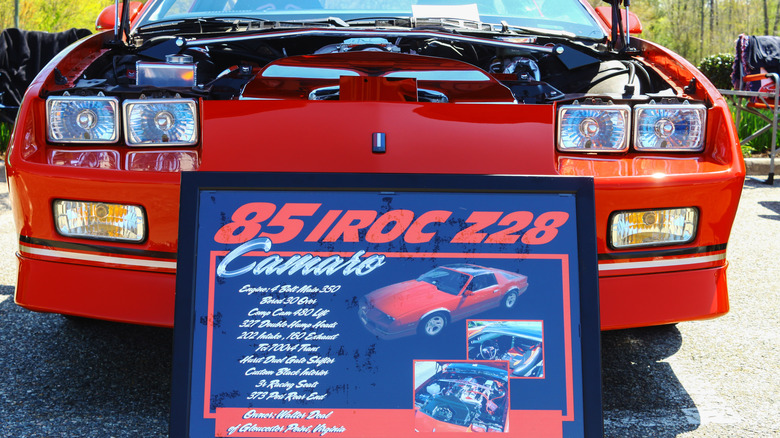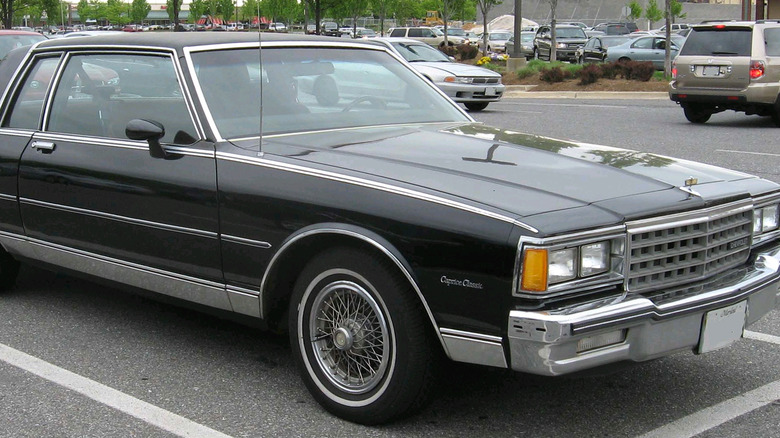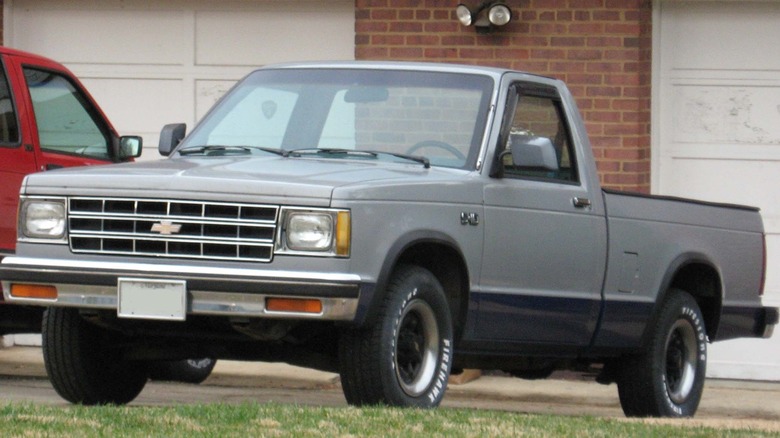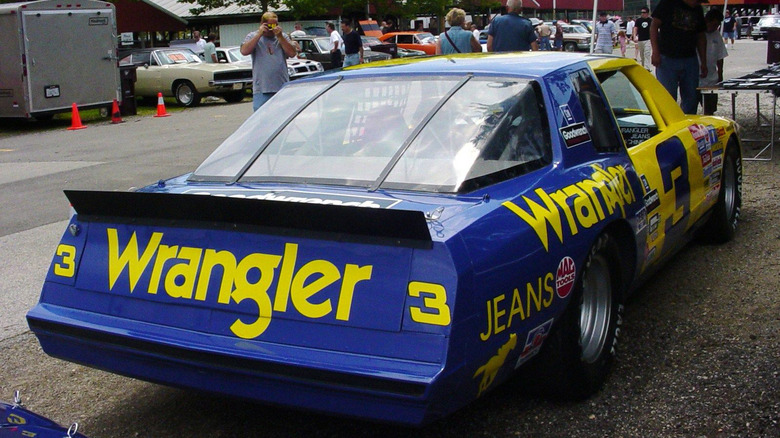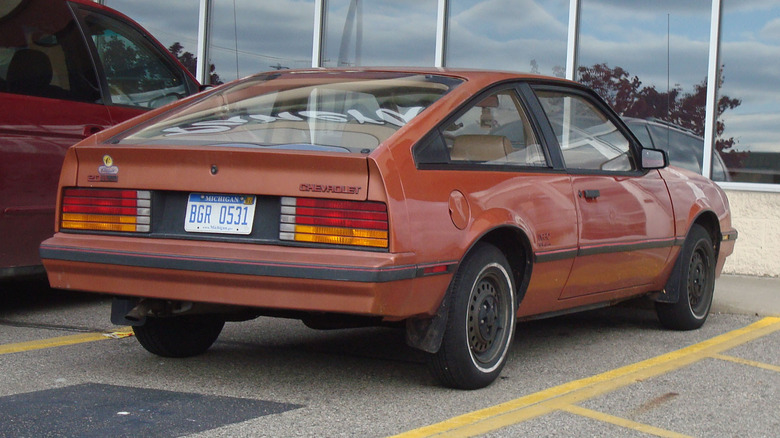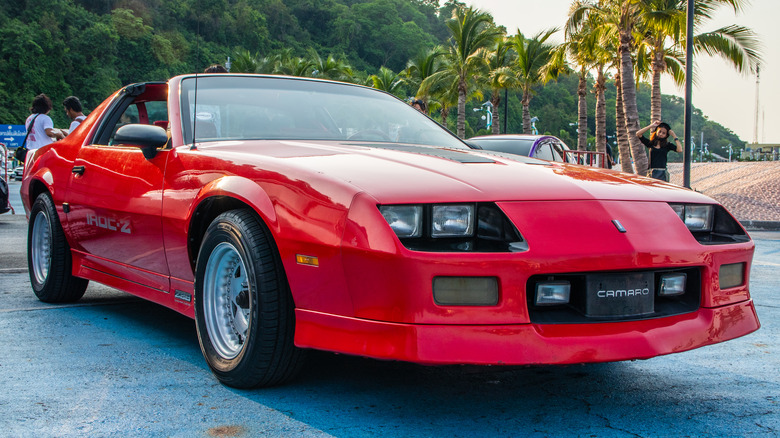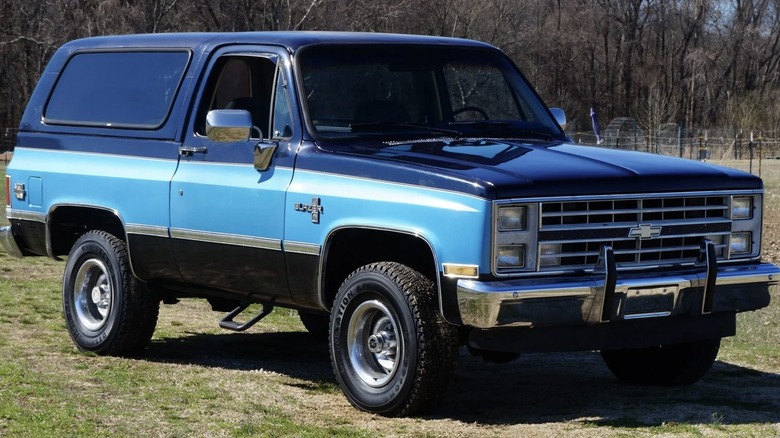6 Chevrolet Models That Ruled The 1980s
Chevrolet was founded in 1911 by Louis Chevrolet and William Durant, and by 1929 Chevy had passed Ford to become the best-selling car brand in the United States. The Corvette appeared in 1953, and the Corvair's distinctive design and mid-engine layout made it a phenomenon when it was introduced in 1960. Chevy produced some absolute beasts during the muscle car era of the 1960s and early '70s, including the racetrack-ready special order COPO Camaro.
That glorious period was followed by the Malaise Era, a term coined by auto journalist Murilee Martin to describe the fallow period that followed the U.S. government's introduction of new emissions and fuel economy standards. The Malaise Era lasted about a decade and ended after 1983, according to Martin. By that point, manufacturers were committed to making cars cool again, and Chevrolet was a major contributor to that effort. These six Chevy models were highlights for the brand and industry in the 1980s — some for innovation, some for sheer popularity, and some for both.
The third-generation Caprice covered the entire decade
The full-sized Caprice was introduced in 1966 and has remained in production ever since, over six generations. The third generation ran from the 1977 through 1990 model years, and the 1977 model was named Motor Trend Car of the Year. Caprices with Chevy's 9C1 law enforcement package were popular with police forces, and the special edition Caprice topped the Michigan State Police's suitability rankings from 1987 through 1996. The third-generation Caprice was 10 inches shorter than its predecessor, but somehow roomier inside.
Another redesign for 1980 made the model boxier yet more aerodynamic thanks to the slimmer front end, and the 1984 Caprice Classic got an impressive 20 miles per gallon in combined city and highway driving. When the Caprice's B-body brother, the Impala, was dropped in 1986, Chevy introduced the Caprice Classic Brougham. That model had some Cadillac-like touches, like the padded roof section behind the rear quarter windows on models with the LS trim. The boxy third-gen Caprice lasted through 1990, after which it was replaced by a more rounded version.
[Featured image by IFCAR via Wikimedia Commons|Cropped and scaled|Public Domain]
The S10 pickup debuted as a 1982 model
Chevrolet introduced the S-10 pickup late in 1981 as a 1982 model. The compact pickup was a replacement for the LUV (light utility vehicle), a model produced throughout the '70s in a partnership with Isuzu. The S-10 was the first compact truck designed and produced solely by an American automaker, and shared its GMT325 platform with the S-10 Blazer, Oldsmobile Bravada, and four GMC cousins: the Sonoma, Syclone, Typhoon, and S-15 Jimmy.
The S-10 was at first only offered with a standard cab, but an extended version was added for the 1983 model year. The S-10 also served as the base for the S-10 Blazer, which joined the full-sized K5 Blazer that same year. The S-10 was offered with four-and six-cylinder gas-fueled engines, and the first generation ran through the 1993 model year, after which the hyphen was dropped from the nameplate. The '80s S-10 helped move American buyers into smaller trucks, and the model lived on through 2004, when it was replaced by the Colorado.
[Featured image by IFCAR via Wikimedia Commons|Cropped and scaled|Public Domain]
Dale Earnhardt won two '80s NASCAR championships in Monte Carlos
The Monte Carlo and Monte Carlo SS were Chevy's representatives on the NASCAR circuit from 1971 through 2007 when the Impala SS took over. During that stretch of over 35 years, Monte Carlos won 16 Cup championships and almost 400 races. The fourth generation of the street-legal Monte Carlo debuted in 1981, with a turbocharged 231 cubic inch V6 as the base engine. The turbo was ditched the following year, and the SS trim returned in 1983 after a 12-year hiatus. That version had a 302 cubic inch (5.0 liter) V8 capable of 175 horsepower and 235 lb-ft of torque, which was enough to get the SS from 0-60 in 8.8 seconds.
That was hardly NASCAR-level performance, but Monte Carlo SS sales climbed steadily from under 5,000 units in 1983 to nearly 36,000 in 1985 (via Motor Trend). A fastback Aerocoupe model was introduced in 1986 as a homologation model for the NASCAR Cup series, but Chevy only made the 200 units necessary to qualify the car for racing. Chevy increased Aerocoupe production to just over 6,000 units in 1987, and Dale Earnhardt drove the model to Cup championship wins in both of those years.
The Cavalier was a surprising mid-80s juggernaut
The Cavalier isn't usually lumped in with Chevrolet's more persistent or high-performance models like the Caprice or Corvette, but it was immensely popular after Chevy brought it to market in 1982. The Cavalier's front-wheel drive J-platform design was the first to be shared among all five divisions of General Motors. Among the Cavalier's cousins was the Cadillac Cimarron, a model that was not received well by the Caddy faithful. The Cavalier, though, was a big hit with Chevy buyers. In its first year, the Cavalier was powered by a 1.8-liter I4 engine that was fed fuel by a Rochester two-barrel carburetor. By 1984, the engine had been upgraded to a 2.0-liter four-banger with electronic fuel injection that boosted fuel economy to a combined 25.3 miles per gallon.
That figure helped the Cavalier become the best-selling model in the United States for the calendar years 1984 and 1985. While unremarkable, the Cavalier was produced in enough body styles to appeal to almost anyone. During the first-generation run that lasted through 1987, it was offered as a sedan and wagon and in three coupe forms: hatchback, sport, or convertible. Over that span, Chevy produced more than two million Cavaliers. The most common variant was the '84 four-door sedan with just over 110,000 made, and the rarest was the prior year's convertible coupe, with only 627 produced.
[Featured image by Taxiguy57 via Wikimedia Commons|Cropped and scaled|Public Domain]
The IROC-Z is peak 1980s
There might not be a more stereotypically '80s car than the Camaro IROC-Z, a special edition of the pony car that Chevy introduced in 1967. The IROC-Z was produced from 1985 through 1990, and took its name from the racing championship that put drivers from the world's various top racing series into identically prepared cars to race against each other. The IROC series began in 1973 using expensive Porsches, but the series switched to the Camaro Z28 two years later. To make the car formidable on the series' varied tracks, the IROC-Z was designed to emphasize fuel economy and handling over flat-out speed.
Despite those allowances, the 1986 IROC-Z bested that year's Ford Mustang LX in a Car And Driver head-to-head test by a tenth of a second from 0-60 and four tenths over a quarter mile. The IROC was officially shelved in 1989 when the racing series switched to Dodges, but some leftover '89s were sold as 1990 models. From 1988 on, the IROC-Z was sold as a standalone model, independent of the Z/28. In the years since, the IROC has become associated with gold-chain wearing cheeseballs from the New Jersey shore, and those of us who came of age in that era mostly remember it as such. That does a disservice to the bulky but capable model, which now goes for an average of just over $25,000, according to Classic.com.
The second-generation K5 Blazer helped make the SUV popular
The full-sized K5 Blazer was well into its second generation when Chevy redesigned it for the 1981 model year. A 4.1-liter straight six was the standard powerplant, but buyers could also opt for 5.0 or 5.7-liter gas-fueled V8s or a 6.2 liter diesel. Automatic transmission Blazers came with full-time four-wheel drive, presaging the wave of similar SUVs that have appeared in the decades since. The K5 Blazer remained relatively unchanged throughout the '80s, but got a redesign in 1992.
During the '80s, it also appeared on contemporary shows "Magnum P.I," Murder, She Wrote," and "MacGyver." By the end of the decade, the K5 was losing market share to the S10 Blazer, and in 1992 the full-sized Blazer and Suburban were updated to share a platform. In 1994, the K5 Blazer was replaced in Chevy's SUV lineup by the Tahoe. Despite its untimely end, the K5 Blazer has lived on in recent television shows "Fargo," "Yellowjackets," and "The Righteous Gemstones."
[Featured image by Bretbmorgan via Wikimedia Commons|Cropped and scaled|CC-By 4.0]
